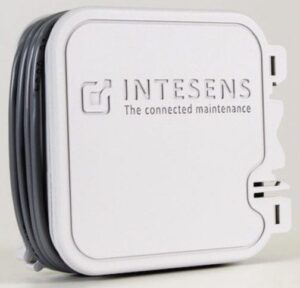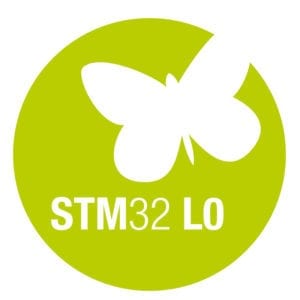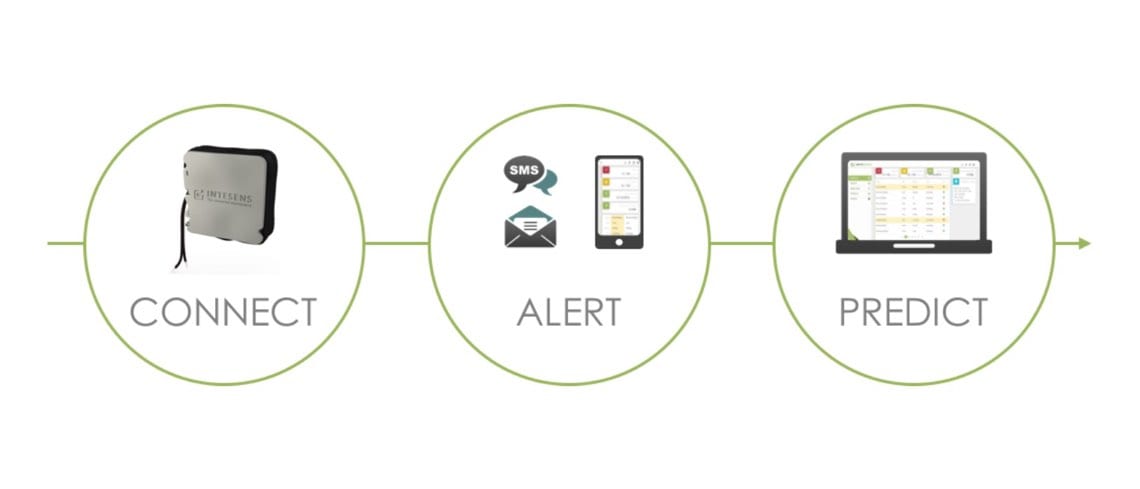As Embedded World 2018 is about to open its doors, it is our privilege to present another partner in our STM32 Fan Zone, Intesens. The French company specializes in maintenance solutions that use sub-gigahertz networks, such as Sigfox or LoRa, to facilitate industrial applications, and although their portfolio of products is quite vast, we’ll focus on only two devices for the sake of brevity and pertinence: the IDIAG Battery and the IDIAG Operate. Intesens will also showcase both of them during Embedded World, and we hope this blog post will drive you to go see their demos in person because they ultimately represent one of the most original IoT applications on the market today, and attendees will be hard pressed to find something quite like it.
In a nutshell, IDIAG Battery is a relatively small box (89 mm x 84 mm x 31 mm) that monitors the backup power supply that kicks in once the main power fails. By using the Sigfox network, the IDIAG Battery can immediately alert the right persons by mail or SMS of a power loss, but also that the backup battery is really doing its job and estimate its remaining lifespan. On the other hand, the IDIAG Operate monitors the electrical behavior of significant assets and can warn operators if the current consumption suddenly increases, which is often a sign of an upcoming malfunction. Hence, thanks to IDIAG Battery and IDIAG Operate, companies with massive infrastructure can now plan their repairs and maintenance operations better, which explains why these products are so successful with corporations like SNCF, the French railway company.
Reason 1: Intesens’ Refusal to Compromise

One of the most remarkable aspects of the IDIAG Battery and IDIAG Operate is the intelligence of both devices. Estimating the health of a backup battery, or of an electrical asset, is complicated. We all know that batteries’ electrolyte fails over time and that components deteriorate, but anticipating failures and replacements demand constant computations, exact models, and the ability to very quickly update them to continue to output relevant data. This is why it’s even more impressive to learn that both the IDIAG Battery and IDIAG Operate run these computations on an STM32L0 microcontroller (MCU). As Jean-Luc Flouttard, Intesens’ Business Developer, explained:
The main intelligence is on the IDIAG device and we only send the relevant data to the cloud. As a result, all the processing operations, major computations, and complex calculations take place on the STM32L0. We use the Sigfox downlink to send the electrical characteristics of the device we are monitoring as a way to setup the IDIAG terminal and inform the models that are running on the MCU. Similarly, we simply use the uplink to update our cloud interfaces and APIs with the necessary information, ensuring that servers remain responsive and efficient.
Obviously, Intesens uses STM32L0 MCUs because they have some of the most efficient power-saving features in the industry. For instance, the MCU’s ultra-low-power mode only demands 230 nA while still powering backup registers and two wakeup pins. This is important because IDIAG terminals must function over many years in the field and demand as little maintenance as possible. For instance, the IDIAG Battery runs for about five years. However, we also see that the company was able to use this MCU and optimize its application to run powerful simulations that can inform maintenance crews with unique data.
Reason 2: STM32L0’s Flexibility and Reliability
 Intesens told us that the STM32L0 also offered an exciting level of flexibility, which explains why many of their other products use STM32 MCUs, and why the IDIAG Battery and the IDIAG Operate use similar PCBs. They are evidently not identical since the company customizes them to fit their applications and the types of measurements they take, but both use MCUs from the same ST family, which greatly simplified development. Indeed, IDIAG Operate is much newer than IDIAG Battery since the former only launched a few months ago. However, by being able to reuse a fair amount of the IDIAG Battery design, Intesens was able to significantly reduce the IDIAG Operate’s time to market, ensuring its portfolio of products answers all of its clients’ needs.
Intesens told us that the STM32L0 also offered an exciting level of flexibility, which explains why many of their other products use STM32 MCUs, and why the IDIAG Battery and the IDIAG Operate use similar PCBs. They are evidently not identical since the company customizes them to fit their applications and the types of measurements they take, but both use MCUs from the same ST family, which greatly simplified development. Indeed, IDIAG Operate is much newer than IDIAG Battery since the former only launched a few months ago. However, by being able to reuse a fair amount of the IDIAG Battery design, Intesens was able to significantly reduce the IDIAG Operate’s time to market, ensuring its portfolio of products answers all of its clients’ needs.
Additionally, the French company highlighted another advantage of the STM32L0: its reliability. Working with SNCF or Enedis, which manages 95% of France’s electrical grid, demands massive installations. Intesens was thus very sensitive to the fact that choosing our MCUs translated into a more straightforward deployment of their terminals because of the component’s quality. STM32L0 has a wide operating temperature range that goes from –40ºC to +125ºC, which ensures that they’ll be running well, no matter the weather conditions. This reliability is fundamental because maintenance crews must have the assurance that their IDIAG terminals will always alert them of any imminent or actual failure of their electrical systems.
Powering Innovation at Embedded World 2018
All of these features mean the IDIAG Battery and IDIAG Operate are very special IoT devices. Today, the most common connected products have very little intelligence in them and count on cloud computing to run most of the calculations. Indeed, a vast majority of IoT systems directly send environmental data to servers which must then make sense of it. On the other hand, Intesens built IoT devices for the smart industries of tomorrow. Each product is powerful enough to run their simulation and robust enough to be the last barrier when all else fails. The future also looks bright for the company who shared with us their plan of studying how machine learning could open the way to better predictive maintenance and add another layer of information and reliability to further assist the teams in charge of keeping our infrastructures running.
We, therefore, invite you to check out the IDIAG Battery and IDIAG Operate in person in our STM32 Fan Zone at Embedded World 2018 and see for yourself how an STM32L0 can transform your preconceived ideas about what IoT products can really do.
